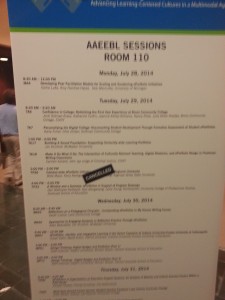And on the third day, we rested… well not really. We heard about and connected with some people at Deakin University who are using the D2L ePortfolio tool in a collaborative way – which is a real limitation that we’ve run into in that even if the permissions on the shared item are “edit”, a presentation is still not editable. It’s a weird problem that seems to stump a lot of us, so it’ll be nice to talk to the people at Deakin who are using ePortfolio in collaboration.
ePortfolio Meets Peer Mentoring
At McMaster, we’re entering year two of the Learning Portfolio and one of the hopes is that students who used it in year one continue to use it in year two as well as mentor new students and offload some of the technical support that we do. Mercy College have a stipend for their peer mentors, who have to complete bi-weekly portfolio tasks which are submitted for assessment against the learning outcomes of the program (which include leadership, personal and professional development). It’s an interesting scenario because our student success office has something similar and is not running into the problems that Mercy College exhibited around time investment to put stuff in their ePortfolio platform (Mercy College uses Digication).
Evaluationg Artifact Selection to Improve EPIC Initiatives at Wentworth Institute of Technology
The first question on my mind was what’s EPIC? Turns out EPIC is External, Problem based, Interdisciplinary Curriculum. What they found was that students added anything that was graded above a B, and was related to their major. Students found that there were three top motivators to keep things up to date – jobs, professors and completion of the course. The real interesting thing is that forming a committee that’s student driven – basically an ePortfolio Advisory Board. I think this is something that we’ve missed here at McMaster.
ePortfolio and the Whole Learner: Intergrating Curricular, Co-Curricular and Experiential Learning
Guttman Community College’s Laura Gambino presented this session which was essentially a very specific use case – Guttman’s curriculum was designed in a very unique way, essentially tailored to the specifics of their student body. This includes a lot of experiential learning, curriculum tied to community based learning and the first year curriculum is very tailored to the Guttman learning outcomes. They use the ePortfolio for integrating learning between the courses – to help transfer and connect knowledge. The first year curriculum is based around a theme like Urban Ecology, and the ePortfolio helps connect the specific course curriculum to that theme by collecting reflections on the theme, and document community based learning days. To “standardize” ePortfolio marking Guttman has Assessment Days to look through portfolios, review processes and use ePortfolio as an LMS itself.
Future of Technology in Higher Education
Bryan Alexander’s keynote was a walk through potential futures of education – depending on how you view what the trends suggest where we might be heading. I can’t really recap the key points because it was something that you should really experience as a whole event. I will say that many of the scenarios were dire for education as we know it. That’s not necessarily bad, it suggests that we might be in for some turbulent times. The best quote of the day was during the keynote:
Social media will become media, media that isn’t social will be asocial.. like Blackboard.
I’m not sure that this is entirely true, I have a bit of a different view of new media in that it doesn’t replace or supplant existing media; it diminishes the prominence of the previous media structure. Social media is diminishing phone calls, letters, e-mail and that sort of long-form personal communication. If we look at previous media shifts, TV didn’t replace radio, DVD/VHS didn’t replace film and so on. Where it does replace existing media (digital photography replacing commercial film photography, telephone replacing the telegraph) it’s really the same media mode – with social media it’s a multimedia thing – social media is pictures, video, text and anything else people create and share. Maybe a slight criticism, but I get what Bryan was getting at. In that social media will become so ubiquitous that it’s just media. There will be very little differentiation between professional media created for consumption and amateur created media as the quality and accessibility of professional grade tools to create media.
